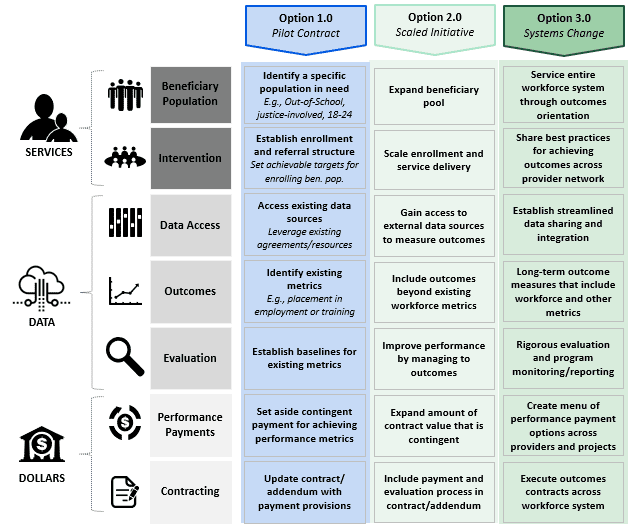Start Small, Think BigImplementing Pay-for-Performance Initiatives around the Nation
When job-seekers gain credentials and degrees, find employment or boost their earnings, use less public benefits, or escape the recidivism cycle, the mission of a local workforce board is being achieved. For years, these outcomes have been aimed at, but not actually incentivized. Enter the Workforce Innovation and Opportunity Act (WIOA), which gives workforce boards around the nation the opportunity to set aside funds that don’t expire during the traditional two-year funding cycle and can be tied to the achievement of outcomes that measurably improve people's lives. Before tapping into these new WIOA Pay-for-Performance (P4P) provisions, workforce organizations have to go through a P4P “feasibility assessment” that produces a viable contracting strategy for measuring and paying for program outcomes.
Third Sector and our partners know that going through this feasibility process takes a lot of work and commitment from different stakeholders. The first workforce boards that explored P4P have wrapped up their P4P feasibility assessments with Third Sector, and several have launched P4P initiatives. In Northern Virginia, the SkillSource Group and the County of Fairfax have executed a P4P contract addendum that focuses on serving foster care and justice-involved young adults, who had previously enrolled in workforce programs in low numbers. The provider will earn “bonus” performance payments for meeting academic and employment outcomes with these traditionally tough-to-reach young people and achieving the same level of success with this group as with the broader population of opportunity youth. The San Diego Workforce Partnership (SDWP) also recently executed an outcomes contract that includes a P4P strategy. Through this innovative contract, SDWP has combined the new flexible P4P funding, a fully performance-driven payment structure, data measurement and evaluation, and the opportunity for more flexible service provision to improve employment, education and recidivism outcomes for justice-involved youth and young adults in San Diego County over the next three and a half years.
To launch these innovative P4P initiatives, workforce boards worked closely with service providers, evaluators, data owners, and workforce experts. While there are different paths to getting to a P4P contract and shifting government resources to pay for outcomes, there are a few guideposts that frame feasibility work.
Through numerous feasibility assessments, Third Sector has seen clients face and overcome a range of different barriers in building out outcomes-contracting initiatives, from lack of data access to funding procurement. While some government partners may not be ready to launch a scaled P4P initiative, there are options for piloting outcomes contracting and then scaling these approaches across an entire program and agency. Third Sector has segmented these potential P4P options into three possible tiers:

By using this flexible framework to implement P4P, workforce organizations can take incremental steps to tie funding to provider outcomes. The P4P 1.0 model helps set up the framework to evaluate longer-term outcomes using existing data sources, while the 2.0 and 3.0 models focus on layering in additional performance metrics, accessing external administrative data sources, and having more rigorous evaluations of outcomes that go beyond the traditional workforce performance measurement cycle.
Through generous funding from the Corporation for National and Community Services’ Social Innovation Fund, as well as funders around the country, workforce organizations in Northern Virginia and San Diego, have gone from initial exploration of P4P to launching contracts that allocate funding to pay for outcomes.
Workforce boards want to see measurable improvements in their constituents’ lives and their communities. WIOA can be a part of a workforce board’s P4P contracting strategy to incentivize and reward partners when they achieve meaningful outcomes. The first step into a more data-driven world is a feasibility study. From there, Third Sector can help workforce boards proceed to real-world P4P, whether slowly at first or full speed ahead.
